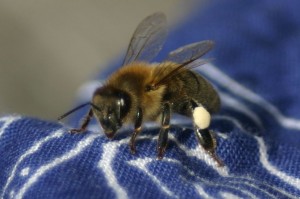Thank you, Bill, for sending me this article:
Scientists discover what’s killing the bees and it’s worse than you thought
When researchers collected pollen from hives on the east coast pollinating cranberry, watermelon and other crops and fed it to healthy bees, those bees showed a significant decline in their ability to resist infection by a parasite called Nosema ceranae. The parasite has been implicated in Colony Collapse Disorder though scientists took pains to point out that their findings do not directly link the pesticides to CCD. The pollen was contaminated on average with nine different pesticides and fungicides though scientists discovered 21 agricultural chemicals in one sample. Scientists identified eight ag chemicals associated with increased risk of infection by the parasite.
Most disturbing, bees that ate pollen contaminated with fungicides were three times as likely to be infected by the parasite. Widely used, fungicides had been thought to be harmless for bees as they’re designed to kill fungus, not insects, on crops like apples.
This makes perfect sense to me.
The health of a hive requires a balance of bacteria, yeasts, fungus, and viruses. This is especially significant in the digestion of each individual bee, AND in the food brought into the hive. Pollen is the protein source to feed developing bees, but it must be lacto-fermented into “bee bread” before it can be used. Introducing pollen from other locations, or moving hives to other places means that the culture of lactic acid forming bacteria are no longer matched to the food (pollen) coming into the hive. Changing cultures is possible, but it takes time–several bee generations (3 weeks each). So it can be done in a summer, maybe once, if the hive is strong to begin with. I’ve had strong hives inexplicably crash and die immediately after moving them, which tells me how big a deal this is.
The bacteria, yeasts, fungus, and viruses keep each other in check. Nosema is a microsporidia (spore forming bacteria), which is treated with a medication named fumagillin. Fumagillin is extracted from the fungus Aspergillus fumigatus that causes stone brood, also a honey bee disease. So if your hive has Nosema (bee diarrhea), its got a bacteria overgrowth. There are too many of the bad bacteria, and not enough of the yeasts, fungus, and viruses to hold it back. The treatment works because it temporarily overloads the hive with fungal by-products, pushing the pendulum back towards the center. Unfortunately, balance is never achieved by pushing a pendulum back from the end of it’s swing.
When the bees forage food covered with fungicides (from commercial fruit orchards for example), the stage is set for Nosema to be a problem because the fungicides remove one leg of the stool–the fungus population.
Feeding bees sugar syrup or HFCS also throws off the balance because these have a lower pH than honey, their natural food. Poor nutrition leads to short lived bees, and the colony dwindles away and gradually dies through the course of the season.
Pesticides add to the stress load of the bees working the fields, and these are absorbed into the bones and liver of the hive–the wax comb. Guess where the infant bees live–surrounded by their hexagonal cell of bees’ wax. The picture is really very simple. For me, it’s amazing that commercial bees are still alive at all!
Feral bees in trees and houses are increasing each year–I’ve got that from many people who remove bees, from my observations, and from the comments of other beekeepers who chase honey bee swarms. That sounds like an opportunity for treatment-free beekeepers. This year isn’t over with yet, but I sure feel good about how my bees are doing which I tend like they still live in a hollow tree.

